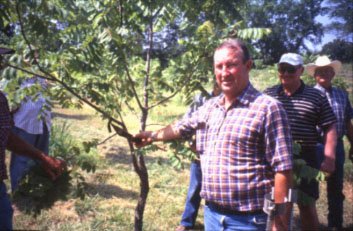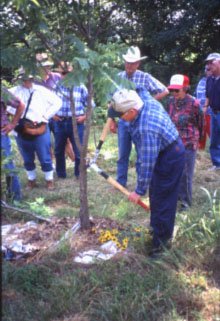A number of new directions are being developed for the Missouri Black Walnut Tree Improvement Program based at the University of Missouri Horticulture and Agroforestry Research Center (HARC) in New Franklin, Mo. The program focuses upon the genetic improvement of this important native species for both nut traits and improved timber characteristics.
A clonal repository (or collection) of over 95 different cultivars has been assembled during the past five years. This genetically diverse material will help determine which cultivars are best suited to central Missouri in terms of flowering and fruiting characteristics, winter hardiness, disease resistance, etc. In the spring of 2000, we began recording information on the date of spring bud break, and the presence of male and female flowers on these young trees. This type of information will help us determine how to design future grafted black walnut orchards for Missouri.
Another project calls for developing new cultivated varieties derived from a black walnut breeding program. These new cultivars would be selected based upon such characteristics as lateral seed bearing, late spring bud break, disease resistance, precocity, nut qualities (shell thickness, crackability), and kernel color. In addition, improvements will be sought in stem straightness and branching habit which are also important timber traits.
Grafted trees representing 48 different cultivars were propagated in the spring of 2000 and will be out-planted in a new breeding orchard site at HARC in the spring of next year. These trees will be grown in a unique trellis system that should allow us to produce more seeds quicker, and on smaller-sized plants. These smaller plants should facilitate the entire controlled breeding process by enabling us to readily observe the ideal timing of the female flower receptivity, for example, as well as other critical components associated with making controlled crosses.
Another important aspect of growing grafted black walnut trees in nut orchards involves
the use of the best rootstocks available. Rootstocks can influence the performance of
grafted nut trees in terms of adaptability to certain soils, winter hardiness, and overall nut
productivity. In order to define the extent of rootstock effects on walnut performance, a
total of 5 popular nut cultivars were grafted onto 4 commercially available seedling
rootstock sources. These grafts will be out-planted at two sites in the spring of 2001 and
observed for a number of years to see what advantage (if any) there might be to using
certain rootstocks in nut orchards.
--Mark V. Coggeshall, University of Missouri Center for Agroforestry


| 
|
| Dr. Robert Littlejohn encouraged discussion on pruning and thinning walnut trees in his Conservation Reserve Program plantation near Aullville. Members toured the Littlejohn farm in July and enjoyed discussion on salvaging CRP tree plantings. | Paul Baker, of Dearborn, makes a selective pruning cut on a walnut tree. |